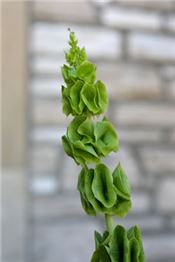Gardening Page
Bells Of Ireland: A St. Patrick's Day favorite

Bells of Ireland.
Photo by Margaret Straw
COLUMBIA, MISSOURI
St. Patrick’s Day is a time to celebrate Irish culture and everything green, including leprechauns and shamrocks. While shamrock is a well- known symbol of good luck, another interesting plant associated with good fortune is bells of Ireland, says University of Missouri Extension horticulturist Michele Warmund.
An annual in the mint family, bells of Ireland (Moluccella laevis) blooms July to September. Each tiny, white flower is surrounded by a bell-shaped, emerald green calyx, with many “bells” tightly arranged along the floral stem.
“As luck would have it, the time to start bells of Ireland seeds indoors is on St. Patrick’s Day,” said Warmund.
She suggests placing the seeds in a shallow container filled with potting medium. Barely cover the seeds, as they require light for germination. Lightly water the potting medium, seal the container, and place it in a refrigerator for two weeks. After refrigeration, seedlings will emerge when the container is placed in a well-lit location at 65-68 F.
Transplant seedlings outdoors when nighttime temperatures are consistently above 40 F, Warmund said. Alternatively, place the seeds on top of the soil when the soil temperature is 50-60 F.
When bells of Ireland flower stalks are left on the plant, they often self-seed. The triangular seeds can be left to scatter on the soil or collected for planting next year.
Although the fragrant flowers are not showy, they remain attractive for an extended period. “Bells of Ireland are interesting as cut stems and can be mixed with other colorful flowers in fresh or dried arrangements,” Warmund said.
For drying, cut the stems when the bells become rigid; hang the stalks in a dry location with good air circulation.
Pests are seldom a problem on bells of Ireland, and the plants are not favored by rabbits or deer, she said.
Bells of Ireland perform best in part shade to early morning sun in a well-drained soil with moderate watering during dry periods.
“They make attractive border plants, especially in cottage gardens, when spaced 10 to 12 inches apart,” Warmund said. Plants grow 2-3 feet high, and tall stems may require staking in windy sites.
In celebration of St. Patrick's Day, Warmund says to remember this slightly modified proverb: “For each flower on bells of Ireland, this brings a wish your way: good health, good luck and happiness for today and every day.” ∆
Free DIY Lawn Care Class Set For April 6

BOWLING GREEN, MISSOURI
You can have a thriving lawn without hiring an expensive service.
“Managing your lawn doesn’t have to be complicated,” says University of Missouri Extension horticulturist Justin Keay. “If you understand some of the basic principles and don’t mind putting in a little sweat equity, you can have a beautiful lawn.”
Don’t know where to get started? A free 90-minute class from MU Extension can help. In time for spring, extension horticulturists Keay and Robert Balek will present “Do-It-Yourself Lawncare Essentials” 6-7:30 p.m. Wednesday, April 6, via Zoom.
Keay says simple changes such as raising your mowing height can help suppress up to 80% of lawn weeds. Overseeding your lawn in the fall is an easy way to fill in bare spots and help prevent weeds from taking over. A soil test can help you understand what nutrients your lawn needs – and what nutrients it doesn’t need, so you can avoid applying unnecessary fertilizer that could contribute to water pollution. “We all have our part to play in protecting our state’s natural resources, including our wonderful rivers, lakes and streams,” Keay says.
“This class will be helpful to new and existing homeowner who are interested in optimizing management of their own lawns,” he adds.
“Folks will leave this class with a good grasp on basic lawn care practices and principles as well as the confidence necessary to start effectively managing their own lawns.”
The class is free but advance registration is required. Sign up at muext.us/DIYlawncare. ∆